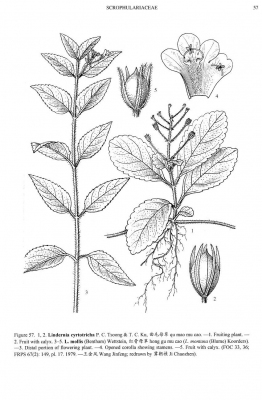Lindernia mollis
(Benth.) Wettst.
Linderniaceae
A recent study in the family Linderniaceae - Fischer E.; Schäferhoff B. & Müller K.: The Phylogeny of Linderniaceae - The New Genus Linderniella, and new combinations within Bonnaya, Craterostigma, Lindernia, Micranthemum, Torenia and Vandellia. Willdenowia 43: 209 - 238. December 2013. ISSN 0511-9618 - has proposed moving several genera from Scrophulariaceae into Lindernia; resurrecting the genera Bonnaya and Vandellia from within Lindernia; and describes a new genus Linderniella. These changes have not yet been accepted - if they do then this species will become Vandellia montana (Blume) Benth.
Diceros montanus Blume
Lindernia montana (Blume) Koord.
Vandellia mollis Benth.
Vandellia montana (Blume) Benth.
Common Name:
General Information
Lindernia mollis is a usually creeping, annual plant with stems 15 - 45cm long. The stems form new roots at the nodes[
266- Title
- Flora of China
- Publication
-
- Author
-
- Website
- http://flora.huh.harvard.edu/china/
- Publisher
- Missouri Botanical Garden Press; St. Louis.
- Year
- 1994
- ISBN
-
- Description
- An excellent, comprehensive resource in 25 volumes. In addition to the botanical information the flora also gives basic information on habitat and some uses. An on-line version is also available.
,
506- Title
- The Flora of British India. (in 7 volumes)
- Publication
-
- Author
- Hooker J.D.
- Website
- http://www.biodiversitylibrary.org
- Publisher
- L.Reeve & Co.; London
- Year
- 1872 - 1897
- ISBN
-
- Description
- Rather dated, but has some information on plant uses. It can be downloaded from the Internet.
].
The plant is harvested from the wild for local use as a medicine.
In spite of its apparent extinction in Bangladesh, the species has a very wide distribution through much of southeast Asia, and is capable of exploiting anthropogenic habitats. The plant is classified as 'Least Concern' in the IUCN Red List of Threatened Species(2013)[
338- Title
- IUCN Red List of Threatened Species
- Publication
-
- Author
-
- Website
- http://www.iucnredlist.org/
- Publisher
-
- Year
- 0
- ISBN
-
- Description
- A list of plants under threat and facing possible extinction, usually with brief details of the threats and information on habitat.
].
Known Hazards
None known
Botanical References
266- Title
- Flora of China
- Publication
-
- Author
-
- Website
- http://flora.huh.harvard.edu/china/
- Publisher
- Missouri Botanical Garden Press; St. Louis.
- Year
- 1994
- ISBN
-
- Description
- An excellent, comprehensive resource in 25 volumes. In addition to the botanical information the flora also gives basic information on habitat and some uses. An on-line version is also available.
Range
E. Asia - China, Pakistan, India, Myanmar, Cambodia, Laos, Vietnam, Malaysia, Indonesia
Habitat
Fields, scrub on sunny mountain slopes, forest edges, along streams; at elevations from 900 - 1,400 metres[
266- Title
- Flora of China
- Publication
-
- Author
-
- Website
- http://flora.huh.harvard.edu/china/
- Publisher
- Missouri Botanical Garden Press; St. Louis.
- Year
- 1994
- ISBN
-
- Description
- An excellent, comprehensive resource in 25 volumes. In addition to the botanical information the flora also gives basic information on habitat and some uses. An on-line version is also available.
].
Properties
| Conservation Status | Least Concern |
| Medicinal Rating |      |
| Habit | Annual |
| Height | 0.30 m |
| Cultivation Status | Wild |
Cultivation Details
Found in the wild in a wide range of habitats from marshy ground to sunny mountain slopes and also on clay soils; it is tolerant of seasonal inundation[
338- Title
- IUCN Red List of Threatened Species
- Publication
-
- Author
-
- Website
- http://www.iucnredlist.org/
- Publisher
-
- Year
- 0
- ISBN
-
- Description
- A list of plants under threat and facing possible extinction, usually with brief details of the threats and information on habitat.
].
Edible Uses
None known
Medicinal
Most Lindernia species are very bitter and many are used medicinally. This is one of several species that are often used more or less interchangeably.to treat dysentery and other intestinal problems[
310- Title
- Plant Resources of Southeast Asia
- Publication
-
- Author
-
- Website
- http://proseanet.org/
- Publisher
-
- Year
- 0
- ISBN
-
- Description
- Lots of information on the uses of the plants of SE Asia.
]. A decoction of the leaves is given after childbirth[
310- Title
- Plant Resources of Southeast Asia
- Publication
-
- Author
-
- Website
- http://proseanet.org/
- Publisher
-
- Year
- 0
- ISBN
-
- Description
- Lots of information on the uses of the plants of SE Asia.
].
The aerial parts are widely used in poultices for relieving boils, sores and itches[
310- Title
- Plant Resources of Southeast Asia
- Publication
-
- Author
-
- Website
- http://proseanet.org/
- Publisher
-
- Year
- 0
- ISBN
-
- Description
- Lots of information on the uses of the plants of SE Asia.
]. The juice of the aerial parts, mixed with turmeric (Curcuma longa) and heated with a little water, is applied to infected fingernails[
310- Title
- Plant Resources of Southeast Asia
- Publication
-
- Author
-
- Website
- http://proseanet.org/
- Publisher
-
- Year
- 0
- ISBN
-
- Description
- Lots of information on the uses of the plants of SE Asia.
].
Other Uses
None known
Propagation
Seed -
If you have any useful information about this plant, please leave a comment. Comments have to be approved before they are shown here.


 Useful Tropical Plants Database 2014 by
Ken Fern,
web interface by
Ajna Fern
with help from
Richard Morris.
Useful Tropical Plants Database 2014 by
Ken Fern,
web interface by
Ajna Fern
with help from
Richard Morris.